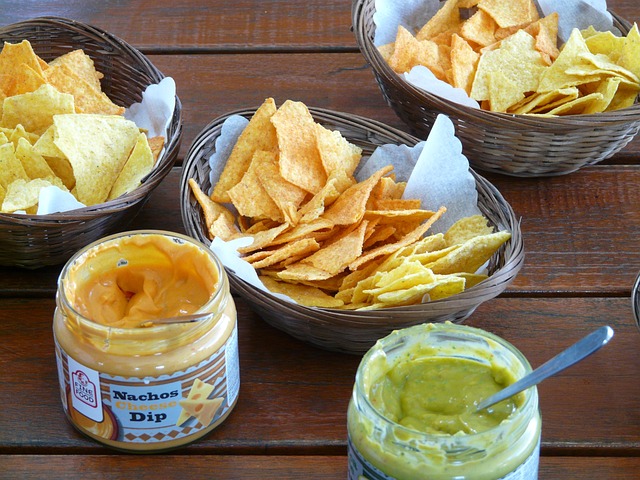This text discusses the need for healthier tortilla chip alternatives due to the high calorie, fat, and sodium content of traditional chips like On The Border Basic Tortilla Chips. It highlights the benefits of low-carb, whole grain, and legume-based snacks, such as On The Border's offering, which are packed with nutrients while providing a satisfying crunch. These chips offer a guilt-free option with moderate calories, essential minerals, and fiber per serving, allowing for versatile snacking or meal creation without compromising dietary goals.
Looking for a healthier alternative to traditional tortilla chips? This comprehensive guide explores nutritious options that satisfy your cravings without compromising well-being. We dive into the nutritional profile and potential drawbacks of conventional chips, uncovering innovative low-carb, whole grain, and legume alternatives. A special focus is given to On The Border Basic Tortilla Chips, examining their ingredients and health benefits. Learn creative ways to enjoy these alternatives and discover tips for seamlessly incorporating them into your diet for a balanced approach.
- Understanding Traditional Tortilla Chips: Nutritional Profile and Potential Drawbacks
- Exploring Healthy Alternatives: A Comprehensive Look at Low-Carb, Whole Grain, and Legume Options
- On The Border Basic Tortilla Chips: Unpacking the Ingredients and Health Benefits
- Creative Ways to Enjoy Healthy Tortilla Chip Alternatives as Snacks or Side Dishes
- Comparison: Taste, Texture, and Versatility of Healthy vs Traditional Tortilla Chips
- Incorporating Low-Carb, Whole Grain Chips into Your Diet: Tips for Balance and Moderation
Understanding Traditional Tortilla Chips: Nutritional Profile and Potential Drawbacks

Traditional tortilla chips, such as those from On The Border Basic Tortilla Chips, are a popular snack choice known for their crispy texture and versatile flavor. Made from corn tortillas that are cut into triangles and fried or baked until golden brown, they offer a satisfying crunch with every dip. However, it’s essential to understand the nutritional profile of these chips to appreciate their potential drawbacks.
Nutritionally, traditional tortilla chips are high in calories, primarily due to their processing and preparation methods. They often contain significant amounts of saturated fat and sodium, which can contribute to health issues like heart disease and hypertension when consumed excessively. Moreover, many brands include added flavors and preservatives, further increasing the overall nutritional concern. These factors highlight the need for healthier alternatives that still satisfy the craving for a crunchy, flavorful snack experience.
Exploring Healthy Alternatives: A Comprehensive Look at Low-Carb, Whole Grain, and Legume Options

When it comes to snacking, transitioning from traditional tortilla chips to healthier alternatives doesn’t have to mean sacrificing taste or crunch. A plethora of options are available that cater to various dietary preferences and restrictions. Among them, low-carb, whole grain, and legume-based alternatives stand out as versatile choices. For instance, On The Border Basic Tortilla Chips offer a conventional chip experience with fewer carbs and more nutritious ingredients, making them ideal for those aiming to cut down on carbohydrates.
Whole grains like quinoa or buckwheat can be ground into flour to create chips with a similar texture but enhanced nutritional value. Legumes, such as chickpeas or black beans, also work wonders when baked into crispy snacks, providing plant-based protein and fiber that promote satiety. These innovative alternatives not only satisfy the desire for crunchy treats but also contribute to a balanced diet, offering a healthier twist on traditional tortilla chips.
On The Border Basic Tortilla Chips: Unpacking the Ingredients and Health Benefits

On The Border Basic Tortilla Chips offers a healthier alternative to traditional chips, with a simple ingredient list that highlights its natural origins. Made from 100% whole grain corn, these chips provide a good source of fiber and essential nutrients like magnesium and zinc. By avoiding artificial additives and preservatives, the brand ensures a cleaner, more wholesome option for snacking.
Each serving (about 28g) contains just 140 calories, making it an excellent choice for those watching their calorie intake. Plus, with a slightly denser texture than typical chips, On The Border Basic Tortilla Chips can satisfy cravings without the guilt. Its neutral flavor profile also makes them versatile, perfect for dipping in salsa, guacamole, or your favorite healthy dip.
Creative Ways to Enjoy Healthy Tortilla Chip Alternatives as Snacks or Side Dishes

Healthy tortilla chip alternatives don’t have to mean sacrificing taste or versatility. If you’re looking for a crunch factor with a twist, try roasting thin slices of sweet potatoes or zucchini for a crispy treat. Season them with a sprinkle of salt and pepper for a simple yet satisfying snack. For a more traditional feel, On The Border Basic Tortilla Chips offer a guilt-free option that can be enjoyed on their own or used as a base for creative dishes.
As a side dish, these chips pair wonderfully with homemade guacamole or a fresh salsa. You can also get inventive by topping them with black beans, cheese, and veggies for a tasty, protein-packed meal. Don’t underestimate the potential of these healthy alternatives—they’re perfect for satisfying cravings while keeping your diet on track.
Comparison: Taste, Texture, and Versatility of Healthy vs Traditional Tortilla Chips

When it comes to a taste test between healthy and traditional tortilla chips, the difference is often subtle yet noticeable. While On The Border Basic Tortilla Chips offer a familiar flavor, their healthier counterparts may have a slightly more nuanced taste, sometimes enhanced by natural ingredients like spices or herbs. This doesn’t mean they lack crunch or saltiness; rather, it’s a matter of balancing health benefits with sensory appeal.
Texture-wise, traditional chips are known for their crispy, snap-in-your-mouth quality, which is largely achieved through deep frying. Healthy alternatives, on the other hand, often employ baking or air-frying methods, resulting in a slightly softer, lighter texture. However, advancements in food technology have led to innovative production techniques that can mimic the satisfying crunch of conventional chips while using healthier oils and ingredients. Versatility is another factor; traditional tortilla chips pair well with various dips, but healthy options are also suitable for countless recipes, from topping salads to adding crunch to veggie stir-fries.
Incorporating Low-Carb, Whole Grain Chips into Your Diet: Tips for Balance and Moderation

If you’re looking for a healthier alternative to traditional tortilla chips, consider incorporating low-carb, whole grain options into your diet. These chips offer a more nutritious choice while still satisfying your craving for something crispy and tasty. Look for brands like On The Border Basic Tortilla Chips, which are made with natural ingredients and provide a lower glycemic index compared to regular potato chips.
To maintain balance and moderation, remember that even healthy alternatives should be consumed in moderation due to their calorie and fat content. Pair them with lighter dips such as guacamole or hummus, and opt for portion control by snacking on them in small, sealed bags. This way, you can enjoy the crispiness and flavor without overindulging.
In conclusion, exploring healthy alternatives to traditional tortilla chips offers a delicious and nutritious path forward. By understanding the potential drawbacks of conventional options, we can make informed choices that support our dietary needs without compromising taste or versatility. From low-carb, whole grain, and legume varieties to creative ways to enjoy them, there’s a world of satisfying alternatives waiting to be discovered. Even examining unique products like On The Border Basic Tortilla Chips, we find ingredients and health benefits that align with modern dietary preferences. Ultimately, incorporating these options into your diet requires balance and moderation, allowing for both indulgence and nutritious choices.
